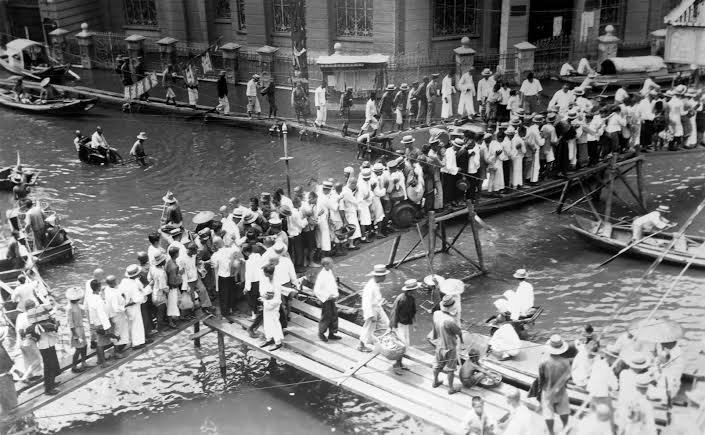The 1931 China floods, or the 1931 Yangtze–Huai River floods, was a devastating flood that occurred from June to August 1931 in China, hitting major cities such as Wuhan, Nanjing and beyond, and eventually culminated in a dike breach along Lake Gaoyou on 25 August 1931.
Fatality estimates vary widely. A field survey by the University of Nanking led by John Lossing Buck immediately after the flood found “150,000 people had drowned, and that this number represented less than a quarter of all fatalities during the first 100 days of the flood.” The official report found 140,000 drowned and claims that “2 million people died during the flood, having drowned or died from lack of food”. A cholera epidemic in the subsequent year, from May 1932, was officially reported to have 31,974 deaths and 100,666 cases.

Death toll and damage
This flood is frequently featured in the list of disasters in China by death toll, sometimes topping lists of the world’s deadliest disasters.
At the time the government estimated that 25 million people had been affected by the flood. Historians since have suggested that the true number may have been as many as 53 million. Estimated death tolls also vary widely. Contemporary studies conducted by John Lossing Buck allege that at least 150,000 people had drowned in the first few months of the flood, with hundreds of thousands more dying of starvation and disease over the following year. Using contemporary media reports, Chinese historians led by Li Wenhai have calculated the death toll at 422,420. Some Western sources allege that the death toll was between 3.7 and 4 million people based on their own claims of famine and disease. The Tanka people who traditionally live on boats along the Yangtze suffered greatly from the flooding.
The flood destroyed vast swaths of housing and farmland. Throughout the entire Yangtze Valley, around 15% of the wheat and rice crops were destroyed, with the proportion being much higher in the flood-affected areas. The disaster also caused an economic shock with the price of vital commodities rising rapidly. The combined ecological and economic impacts of the disaster caused many areas to descend into famine. With no food, people were reduced to eating tree bark, weeds, and earth. Some sold their children to survive, while others resorted to cannibalism. The most lethal effect of the flood was the diseases that swept through the refugee population due to displacement, overcrowding, and the breakdown of sanitation. These included cholera, measles, malaria, dysentery, and schistosomiasis.

As well as inundating rural areas, the flood caused widespread destruction to a number of cities. Refugees had been arriving in the city of Wuhan since the late spring. When the city itself was inundated in the early summer and after a catastrophic dike failure at just before 6:00 AM on 27 July,[20]: 270 around 782,189 urban citizens and rural refugees were left homeless. The flood covered an area of 83 square kilometres (32 sq mi) and the city was flooded under many feet of water for close to three months.: 269–270 Large numbers gathered on flood islands throughout the city, with 30,000 sheltering on a railway embankment in central Hankou. With little food and a complete breakdown in sanitation, thousands soon began to succumb to diseases.
There was no warning, only a sudden great wall of water. Most of Wuhan’s buildings in those days were only one story high, and for many people there was no escape- they died by the tens of thousands. … I was just coming off duty at the company’s main office, a fairly new three-story building near the center of town … When I heard the terrible noise and saw the wall of water coming, I raced to the top story of the building. … I was in one of the tallest and strongest buildings left standing. At that time no one knew whether the water would subside or rise even higher.

— Jin Shilong, Senior Engineer at the Hubei Flood Prevention Agency, : 270
The city of Nanjing, then the capital of Republican China, was also severely affected by the disaster. One of the most disastrous single events during the flood occurred on 25 August 1931, when the water rushing through the Grand Canal washed away dikes near Gaoyou Lake. In Gaoyou County alone, 18,000 people drowned and 58,000 died due to famine and diseases the following year.










Leave a Reply